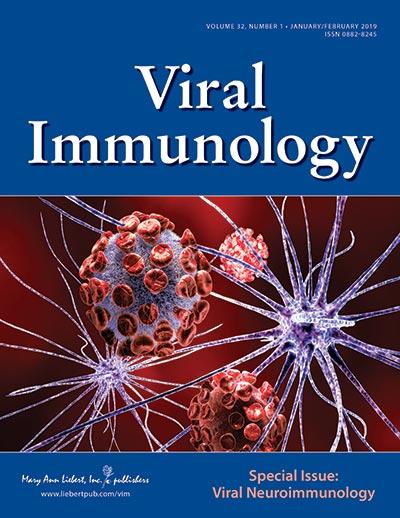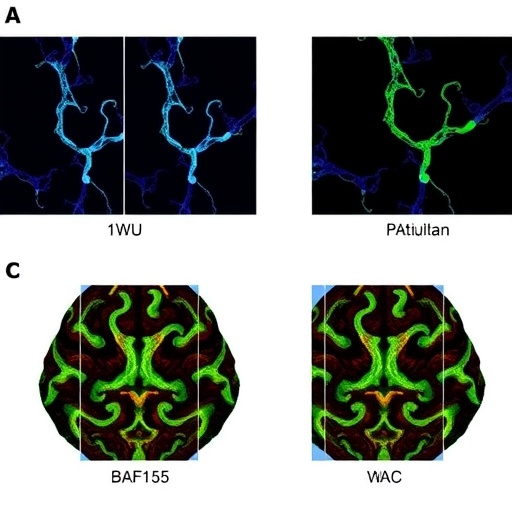
Credit: Mary Ann Liebert, Inc., publishers
New Rochelle, NY, January 16, 2019–A special issue of Viral Immunology, a peer-reviewed journal from Mary Ann Liebert, Inc., publishers, contains a rich collection of the latest research and reviews focusing on Viral Neuroimmunology and the intricacies of viral brain infection. The special issue was led by Guest Editor Karin Peterson, PhD, Senior Investigator, National Institutes of Health (Bethesda, MD). Click here to read the issue free on the Viral Immunology website through February 16, 2019.
A review coauthored by Mihyun Hwang and Cornelia Bergmann, Cleveland Clinic Foundation (OH), and entitled “Intercellular Communication Is Key for Protective IFNα/ß Signaling During Viral CNS Infection,” highlights an early stage in brain infection by RNA viruses. The researchers describe IFNα/ß as a first line of defense to limit the dissemination of virus and discuss the emerging role of astrocytes as early cell responders, inducing IFNα/ß to establish an “antiviral” state.
Dominic Skinner and Thomas Lane, University of Utah School of Medicine (Salt Lake City) and Brett Marro, University of California, Irvine, contributed the article “The Chemokine CXCL10 and Coronavirus-Induced Neurologic Disease,” in which they describe on the role of chemokines in attracting T cells to the brain in a model of viral-induced neurologic disease. The researchers describe studies demonstrating the important role the CXCL10 and its signaling pathway in host defense in a mouse model of viral-induced encephalomyelitis.
In “Brain-Resident T-Cells Following Viral Infection,” coauthors Sujata Prasad and James Lokensgard, University of Minnesota (MN), focus on the development of long-term memory T-cells in the brain that can provide immediate defense against recurrent or reactivated viral infection. The authors discuss the brain resident-memory T-cells, how they become established and the important role chemokines play in this process, and the role of these T-cells in defense of the brain.
“Huge strides are being made in our understanding of immune responses to encephalitic viruses. This special issue outlines these advances with a focus on new ideas and concepts,”says David L. Woodland, PhD, Editor-in Chief of Viral Immunology and Adjunct Member of the Trudeau Institute in Saranac Lake, NY.
###
Research reported in this publication was supported by grants from National Institutes of Health under Award Numbers P01NS064932, R01NS041249, R01NS091939, NS-038836, and MH-066703. The content is solely the responsibility of the authors and does not necessarily represent the official views of the National Institutes of Health.
About the Journal
Viral Immunology is an authoritative peer-reviewed journal published ten times a year in print and online. Topics cover both human and animal viral immunology, exploring viral-based immunological diseases, pathogenic mechanisms, and virus-associated tumor and cancer immunology. The Journal includes original research papers, review articles, and commentaries covering the spectrum of laboratory and clinical research and exploring developments in vaccines and diagnostics targeting viral infections. Tables of content and a sample issue may be viewed on the Viral Immunology website.
About the Publisher
Mary Ann Liebert, Inc., publishers is a privately held, fully integrated media company known for establishing authoritative peer-reviewed journals in many promising areas of science and biomedical research, including Journal of Interferon and Cytokine Research, AIDS Research and Human Retroviruses, and Health Security. Its biotechnology trade magazine, GEN (Genetic Engineering & Biotechnology News), was the first in its field and is today the industry’s most widely read publication worldwide. A complete list of the firm’s 80 journals, books, and newsmagazines is available on the Mary Ann Liebert, Inc., publishers website.
Media Contact
Kathryn Ryan
[email protected]
914-740-2250
Original Source
https:/




